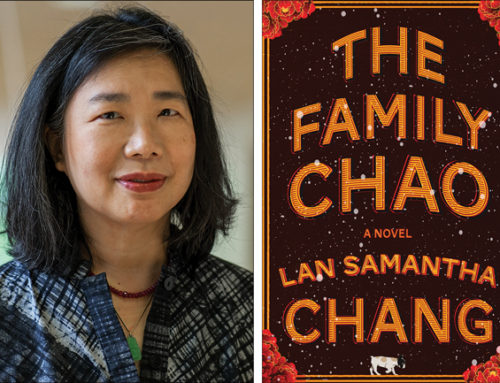By fiction director Lakin Khan
At our conference in 2010, Michael Byers had the honor of reading the first night, a plein-air reading in the cool of approaching nightfall, sunset plying along the mountain behind him, full moon nosing its way up in the East. The onrush of words and sensation was the perfect opening for the week.
An Oberlin College graduate and a former Stegner Fellow at Stanford University, Michael Byers earned his MFA at the University of Michigan’s Creative Writing Program, where he now teaches and in 2013 became the Director of the Helen Zell Writing Program there. He did have a stint teaching at the University of Pittsburgh for three years, and it was in an interview in that university’s journal, Hot Metal Bridge, that Robert Yune wrote that Byers “was noted for his brilliant and generous teaching style, colorful dress shirts, and basketball skills.”
As I remember it that summer, his workshop participants had the privilege of experiencing his excellent teaching; we did see a few of his colorful dress shirts; but we never did put his basketball skills to the test. Perhaps this summer, we’ll find a hoop and see what happens.
The world has acknowledged Michael Byers as a fine writer on the full court of literature and a master in the play of language. As Thomas Mallon wrote in the Atlantic Magazine: “[Byers] displays a virtuosity with figurative language that puts him in a class with such new American masters as Charles Baxter and Antonya Nelson.” Recognition has followed suit: his work has appeared in Best American Short Stories and in Prize Stories: The O. Henry Awards and his books have been New York Times “Notables,” among other awards and prizes.
I, myself, have fallen for his poetic, precise descriptions of place and atmosphere, his talent for the apt and unique as we see here in this excerpt from a books once tentatively tiled The Elements of Orbit:
The wheat in his arms is fresh and springy. If you leave your rake in one place too long the grasshoppers will crawl onto the handle and start gnawing, swiveling their mechanical heads, getting at the sweaty wood. If you upturn a damp patch out comes a cloud of long-legged Dutch flies, so wispy and transparent they are hardly visible, nip-ends of thread and knotted cellophane.
I’m not familiar with Dutch flies, but I can sure see them; I almost swat them away as I read, those wispy, transparent things.
His first book, a collection of short stories titled The Coast of Good Intentions, is set in the Pacific North West, where there’s plenty of damp, moody atmosphere to describe; it won both the Sue Kaufman Prize for First Fiction and the Whiting Award. Of this book, Chris Power of The Times of London wrote; “Byers’s stories are imprinted with humour, intelligence and grace. This faultless collection’s resonances are universal, as is the author’s uncannily skilled turn of phrase.” Recently, in an address for a fund-raiser for The Missouri Review, Byers tells the tale of the journal publishing his first story, which became the first story in the collection, and all that it led to.
In the previously mentioned interview with Richard Yune, Byers talked about his writing process, noting that “Minor characters are great. They don’t bear the responsibility for carrying the narrative weight, so they act as these sort of free radicals in a novel. When I teach, I usually refer to them as ‘neutrinos.'”
It’s not surprising to hear scientific terms put to such interesting use. Byers grew up in Seattle, where his father worked a geneticist. Both of these elements directly informed his second book, the novel Long for This World, which won the First Novel Award from Virginia Commonwealth University and the Annual Prize for Fiction from the Friends of American Writers.
Set in Seattle just before the dot-com bust of the early aughts — “amid the circuslike, pesto-intense, artisan-balsamic-vinegar-heavy, recycled-lumber-floorboards insanity of that time, with easy money to be had seemingly everywhere,” as Byers describes it — a molecular geneticist wrestles with an ethical dilemma involving a dying child, while his own family swirls around him, each on their own particular orbit, sometimes bumping into each other, more often sliding by. “The shimmering delight,” wrote Lucy Beresford in The Literary Review, “of Byers’ almost sensual prose is juxtaposed with harsh clinical realities; fear of the unknown is set against the thrill of uncharted territory; and a child with no future dreams of being healthy in a parallel universe. It is about survival, and hope, and I savoured every page.”
In a keynote address titled “Flounders and Tigers” given to the Department of Genetics of the University of Michigan, Byers talked about the twin origins of the novel: a gunfight in San Francisco he once witnessed and his geneticist father – it’s worth checking out!
A third book, Percival’s Planet, was published in 2010. The novel is an enthralling evocation of the historical events surrounding the discovery of Pluto, our ninth planet, by Clyde Tombaugh, farmhand and amateur telescope maker. The Kirkus Review called it “A closely observed saga of scientific discovery—but with stolen kisses, madness and plenty of other complications.” Sadly enough, Pluto has recently been demoted from planet to just a large orbiting rock, but this does not diminish the appeal and intrigue of the book.
In 2011, Byers released a novella for Kindle, The Broken Man, (also available in print). Visit Byers’ website for much more about his books as well as links to the above speeches and several short stories. And apply today to join his workshop; spots are going fast!







